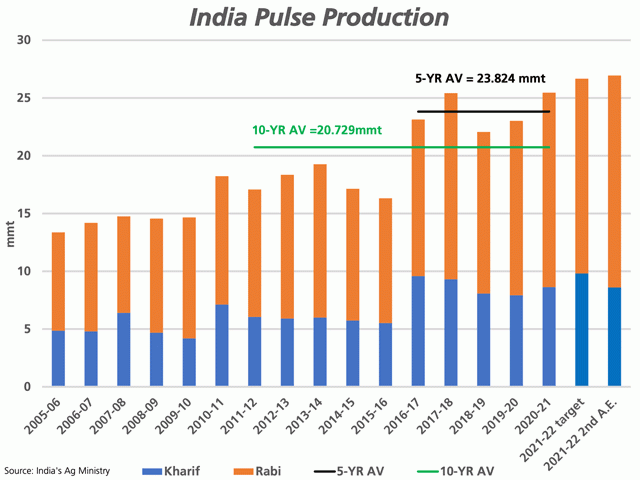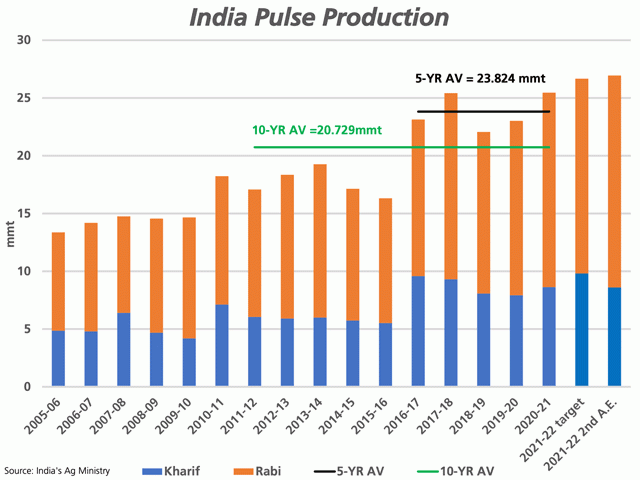Canada Markets
India Releases Second Advance Estimates
India's Directorate of Economics and Statistics released its Second Advance Estimates of grain production on Feb. 16, which includes its first estimates for the winter crop and total grain production for 2021-22.
Another record crop is expected for the country overall, with total foodgrain production forecast at 316.06 million metric tons (mmt), up 5.32 mmt or 1.7% from the previous crop year. This is a fresh record for the country; should total production exceed the 310.74 mmt produced in 2020-21, a record production will have been achieved for six consecutive crop years. The compound annual growth rate is 3.9% during this six-year period.
The size of the nation's wheat crop is estimated at a record 111.32 mmt, which if achieved, represents a seventh consecutive increase in production. The February USDA World Agricultural Supply and Demand Estimates (WASDE) report included an upward revision in India's export potential from 5.25 mmt in January to a record 7 mmt in February, up 173% from the previous year. It is interesting to note that the USDA's production forecast is 1.5 mmt lower than India's forecast at 109.520 mmt.
Total production of the nine oilseeds is estimated at a record 37.1 mmt, up 3.3% or 1.2 mmt from the previous crop year. Production of rapeseed and mustard is forecast at a record 11.5 mmt, up from 10.2 mmt estimated for 2020-21. This production estimate is above the 10.8 mmt currently estimated by the USDA.
P[L1] D[0x0] M[300x250] OOP[F] ADUNIT[] T[]
As seen on the attached chart, India's pulse production is forecast for 2021-22 at 26.950 mmt, up from 25.462 mmt in 2020-21, the five-year average of 23.824 mmt and the 10-year average of 20.729 mmt.
This month's report saw the kharif (summer pulse crop) revised lower from 9.45 mmt estimated in September to 8.61 mmt, or 0.01 mmt below the estimate for 2020-21. At the same time, the first estimate for the winter or rabi crop was released today at 18.34 mmt, or 1.5 mmt higher than achieved in 2020-21.
It's not in the bin yet. It is interesting to note that on Feb. 13, numerous sources reported that India cut its import tariff for lentils from 11% to zero for suppliers other than the United States, down from as high as 33% that was initiated in 2017. This will remain in place until September 30. As reported by Graincentral.com, "The timing of the current policy change is shocking for Indian farmers, given that India is expecting a record crop of lentils this season, and harvest is only a few weeks away," as stated by CEO of AgPulse Analytica CEO Gaurav Jain.
Despite the removal of the tariff, Statpub.com reports further weakness in this week's bids delivered to Saskatchewan plants when compared to the weekly prices reported by Saskatchewan Agriculture as of Feb. 10. This bears watching.
**
DTN 360 Poll
This week's DTN 360 poll asks your opinions about your approach to secure herbicide supplies for 2022. Please weigh in with your thoughts; you can find the poll on the lower-right side of your DTN Home Page.
Cliff Jamieson can be reached at cliff.jamieson@dtn.com
Follow him on Twitter @Cliff Jamieson
(c) Copyright 2022 DTN, LLC. All rights reserved.






Comments
To comment, please Log In or Join our Community .